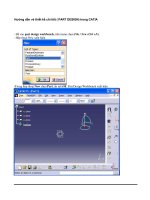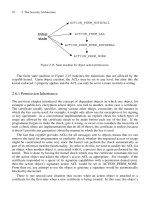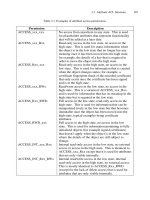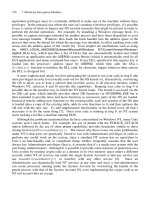Expert one-on-one J2EE Design and Development phần 1 doc
Bạn đang xem bản rút gọn của tài liệu. Xem và tải ngay bản đầy đủ của tài liệu tại đây (2.12 MB, 69 trang )
Expert one-on-one J2EE Design and Development
Rod Johnson
Wrox Press Ltd.
First Printed October 2002
Brought to you by ownSky
What you need to use this book
To run the samples in this book you will need:
❑ Java 2 Platform, Standard Edition SDK v 1.3 or above
❑ A J2EE 1.3-compliant application server. We used JBoss 3.0.0 for the sample application.
❑ An RDBMS. We used Oracle 8.1.7i for the sample application
❑ Apache Log4j 1.2
❑ An implementation of the JSP Standard Tag Library (JSTL) 1.0
Summary of Contents
Introduction 1
Chapter 1: J2EE Architectures 15
Chapter 2 J2EE Projects: Choices and Risks 43
Chapter 3: Testing J2EE Applications 73
Chapter 4: Design Techniques and Coding Standards for J2EE Projects 113
Chapter 5: Requirements for the Sample Application 179
Chapter 6: Applying J2EE Technologies 203
Chapter 7: Data Access in J2EE Applications 251
Chapter 8: Data Access Using Entity Beans 285
Chapter 9: Practical Data Access 311
Chapter 10: Session Beans 363
Chapter 11: Infrastructure and Application Implementation 393
Chapter 12: Web-Tier MVC Design 441
Chapter 12: Views in the Web Tier 515
Chapter 14: Packaging and Application Deployment 583
Chapter 15: Performance Testing and Tuning an Application 611
Chapter 16: Conclusion: Making J2EE Work for You 675
Appendix A: Implementing View Technologies 683
Index 711
"Rod Johnson has done a superb job of covering the design and technical aspects of successfully
building J2EE applications. Rod's straight forward and no-nonsense approach to J2EE application
design, development and deployment has earned his book a permanent place on my bookshelf."
- John Carnell, Principal Architect, Centare Group
Brought to you by ownSky
Brought to you by ownSky
Brought to you by ownSky
Brought to you by ownSky
Brought to you by ownSky
Brought to you by ownSky
Brought to you by ownSky
Brought to you by ownSky
Brought to you by ownSky
Brought to you by ownSky
Brought to you by ownSky
Brought to you by ownSky
Brought to you by ownSky
Brought to you by ownSky
Brought to you by ownSky
J2EE Architectures
J2EE provides many architectural choices. J2EE also offers many component types (such as servlets,
EJBs, JSP pages, and servlet filters), and J2EE application servers provide many additional services.
While this array of options enables us to design the best solution for each problem, it also poses
dangers. J2EE developers can be overwhelmed by the choices on offer, or can be tempted to use
infrastructure inappropriate to the problem in hand, simply because it's available.
In this book I aim to help professional J2EE developers and architects make the appropriate choices to
deliver high-quality solutions on time and within budget. I'll focus on those features of J2EE that have
proven most useful for solving the commonest problems in enterprise software development.
In this chapter, we discuss the high-level choices in developing a J2EE architecture, and how to decide
which parts of J2EE to use to solve real problems. We'll look at:
❑ Distributed and non-distributed applications, and how to choose which model is appropriate
❑ The implications for J2EE design of changes in the EJB 2.0 specification and the emergence of
web services
❑ When to use EJB
❑ Data access strategies for J2EE applications
❑ Four J2EE architectures, and how to choose between them
❑ Web tier design
❑ Portability issues
Chapter 1
16
This book reflects my experience and discussions with other enterprise architects. I will attempt to
justify the claims made in this chapter in the remainder of the book. However, there are, necessarily,
many matters of opinion.
In particular, the message I'll try to get across will be that we should apply J2EE to
realize OO design, not let J2EE technologies dictate object design.
Familiarity with J2EE components has been assumed. We'll take a close look at container services
in the following chapters, but please refer to an introductory book on J2EE if the concepts discussed
are unfamiliar.
Goals of an Enterprise Architecture
Before we begin to examine specific issues in J2EE architecture, let's consider what we're trying to achieve.
A well-designed J2EE application should meet the following goals. Note that while we're focusing on
J2EE-based solutions, these goals apply to all enterprise applications:
❑ Be robust
Enterprise software is important to an organization. Its users expect it to be reliable and bug-
free. Hence we must understand and take advantage of those parts of J2EE that can help us
build robust solutions and must ensure that we write quality code.
❑ Be performant and scalable
Enterprise applications must meet the performance expectations of their users. They must also
exhibit sufficient scalability – the potential for an application to support increased load, given
appropriate hardware. Scalability is a particularly important consideration for Internet
applications, for which it is difficult to predict user numbers and behavior. Understanding the
J2EE infrastructure is essential for meeting both these goals. Scalability will typically require
deploying multiple server instances in a cluster. Clustering is a complex problem requiring
sophisticated application server functionality. We must ensure that our applications are
designed so that operation in a cluster is efficient.
❑ Take advantage of OO design principles
OO design principles offer proven benefits for complex systems. Good OO design practice is
promoted by the use of proven design patterns – recurring solutions to common problems.
The concept of design patterns was popularized in OO software development by the classic
book Design Patterns: Elements of Reusable Object-Oriented Software from Addison Wesley, (ISBN 0-
201-63361-2), which describes 23 design patterns with wide applicability. These patterns are
not technology-specific or language-specific.
It's vital that we use J2EE to implement OO designs, rather than let our use of J2EE dictate
object design. Today there's a whole "J2EE patterns" industry. While many "J2EE patterns"
are valuable, classic (non-technology-specific) design patterns are more so, and still highly
relevant to J2EE.
J2EE Architectures
17
❑ Avoid unnecessary complexity
Practitioners of Extreme Programming (XP) advocate doing "the simplest thing that could
possibly work". We should be wary of excessive complexity that may indicate that an
application architecture isn't working. Due to the range of components on offer, it's tempting
to over-engineer J2EE solutions, accepting greater complexity for capabilities irrelevant to the
business requirements. Complexity adds to costs throughout the software lifecycle and thus
can be a serious problem. On the other hand, thorough analysis must ensure that we don't
have a naïve and simplistic view of requirements.
❑ Be maintainable and extensible
Maintenance is by far the most expensive phase of the software lifecycle. It's particularly
important to consider maintainability when designing J2EE solutions, because adopting
J2EE is a strategic choice. J2EE applications are likely to be a key part of an organization's
software mix for years, and must be able to accommodate new business needs.
Maintainability and extensibility depend largely on clean design. We need to ensure that
each component of the application has a clear responsibility, and that maintenance is not
hindered by tightly-coupled components.
❑ Be delivered on time
Productivity is a vital consideration, which is too often neglected when approaching J2EE.
❑ Be easy to test
Testing is an essential activity throughout the software lifecycle. We should consider the
implications of design decisions for ease of testing.
❑ Promote reuse
Enterprise software must fit into an organization's long term strategy. Thus it's important to
foster reuse, so that code duplication is minimized (within and across projects) and investment
leveraged to the full. Code reuse usually results from good OO design practice, while we
should also consistently use valuable infrastructure provided by the application server where it
simplifies application code.
Depending on an application's business requirements, we may also need to meet the following goals:
❑ Support for multiple client types
There's an implicit assumption that J2EE applications always need to support multiple J2EE-
technology client types, such as web applications, standalone Java GUIs using Swing or other
windowing systems or Java applets. However, such support is often unnecessary, as "thin" web
interfaces are being more and more widely used, even for applications intended for use within
an organization (ease of deployment is one of the major reasons for this).
❑ Portability
How important is portability between resources, such as databases used by a J2EE
application? How important is portability between application servers? Portability is not an
automatic goal of J2EE applications. It's a business requirement of some applications, which
J2EE helps us to achieve.
The importance of the last two goals is a matter of business requirements, not a J2EE
article of faith. We can draw a dividend of simplicity that will boost quality and reduce
cost throughout a project lifecycle if we strive to achieve only goals that are relevant.
Chapter 1
18
Deciding Whether to Use a Distributed Architecture
J2EE provides outstanding support for implementing distributed architectures. The components of a distributed
J2EE application can be split across multiple JVMs running on one or more physical servers. Distributed J2EE
applications are based on the use of EJBs with remote interfaces, which enable the application server to conceal
much of the complexity of access to and management of distributed components.
However, J2EE's excellent support for distributed applications has led to the misconception that J2EE is
necessarily a distributed model.
This is a crucial point, as distributed applications are complex, incur significant
runtime overhead, and demand design workarounds to ensure satisfactory
performance.
It's often thought that a distributed model provides the only way to achieve robust, scalable
applications. This is questionable. It's possible to cluster applications that collocate all their
components in a single JVM.
Distributed architectures deliver the following benefits:
❑ The ability to support many clients (possibly of different types) that require a shared "middle
tier" of business objects. This consideration doesn't apply to web applications, as the web
container provides a middle tier.
❑ The ability to deploy any application component on any physical server. In some applications,
this is important for load balancing. (Consider a scenario when a web interface does a modest
amount of work, but business objects do intensive calculations. If we use a J2EE distributed
model, we can run the web interface on one or two machines while many servers run the
calculating EJBs. At the price of performance of each call, which will be slowed by the
overhead of remote invocation, total throughput per hardware may be improved by
eliminating bottlenecks.)
However, distributed architectures give rise to many tough problems, especially:
❑ Performance problems
Remote invocations are many times slower than local invocations.
❑ Complexity
Distributed applications are hard to develop, debug, deploy, and maintain.
❑ Constraints on practicing OO design
This is an important point, which we'll discuss further shortly.
Distributed applications pose many interesting challenges. Due to their complexity, much of this book
(and J2EE literature in general) is devoted to distributed J2EE applications. However, given a choice it's
best to avoid the complexities of distributed applications by opting for a non-distributed solution.
J2EE Architectures
19
In my experience, the deployment flexibility benefits of distributed applications are
exaggerated. Distribution is not the only way to achieve scalable, robust applications.
Most J2EE architectures using remote interfaces tend to be deployed with all
components on the same servers, to avoid the performance overhead of true remote
calling. This means that the complexity of a distributed application is unnecessary,
since it results in no real benefit.
New Considerations in J2EE Design
The J2EE 1.2 specification offered simple choices. EJBs had remote interfaces and could be used only in
distributed applications. Remote Method Invocation (RMI) (over JRMP or IIOP) was the only choice for
supporting remote clients.
Since then, two developments – one within J2EE and the other outside – have had profound
implications for J2EE design:
❑ The EJB 2.0 specification allows EJBs to have local interfaces, in addition to or instead of, remote
interfaces. EJBs can be invoked through their local interfaces by components in an integrated J2EE
application running in same JVM: for example, components of a web application.
❑ The emergence of the XML-based Simple Object Access Protocol (SOAP) as a widely
accepted, platform-agnostic standard for RMI, and widespread support for web services.
EJB 2.0 local interfaces were introduced largely to address serious performance problems with EJB 1.1
entity beans. They were a last-minute addition, after the specification committee had failed to agree on
the introduction of "dependent objects" to improve entity bean performance. However, local interfaces
have implications reaching far beyond entity beans. We now have a choice whether to use EJB without
adopting RMI semantics.
While some of the bolder claims for web services, such as automatic discovery of services through
registries, are yet to prove commercially viable, SOAP has already proven its worth for remote
procedure calls. SOAP support is built into Microsoft's .NET, J2EE's leading rival, and may supersede
platform-specific remoting protocols. The emergence of web services challenges traditional J2EE
assumptions about distributed applications.
One of the most important enhancements in the next release of the J2EE specifications will be the
integration of standard web services support. However, several excellent, easy-to-use, Java toolsets allow
J2EE 1.3 applications to implement and access web services. See, for example, Sun's Java Web Services
Developer Pack ( and the Apache Axis SOAP
implementation ( />With EJB local interfaces and web services, we can now use EJB without RMI, and
support remote clients without EJB. This gives us much greater freedom in designing
J2EE applications.
Chapter 1
20
When to Use EJB
One of the most important design decisions when designing a J2EE application is whether to use EJB.
EJB is often perceived to be the core of J2EE. This is a misconception; EJB is merely one of the choices
J2EE offers. It's ideally suited to solving some problems, but adds little value in many applications.
When requirements dictate a distributed architecture and RMI/IIOP is the natural remoting protocol, EJB
gives us a standard implementation. We can code our business objects as EJBs with remote interfaces and
can use the EJB container to manage their lifecycle and handle remote invocation. This is far superior to a
custom solution using RMI, which requires us to manage the lifecycle of server-side objects.
If requirements don't dictate a distributed architecture or if RMI/IIOP isn't the natural remoting
protocol, the decision as to whether to use EJB is much tougher.
EJB is the most complex technology in J2EE and is the biggest J2EE buzzword. This can lead to
developers using EJBs for the wrong reasons: because EJB experience looks good on a resum ; because
there is a widespread belief that using EJB is a best practice; because EJB is perceived to be the only
way to write scalable Java applications; or just because EJB exists.
EJB is a high-end technology. It solves certain problems very well, but should not be used without good
reason. In this section we'll take a dispassionate look at the implications of using EJB, and important
considerations influencing the decision of whether to use EJB.
Implications of Using EJB
One of the key goals of the EJB specification is to simplify application code. The EJB 2.0 specification
(§2.1) states that "The EJB architecture will make it easy to write applications: Application developers
will not have to understand low-level transaction and state management details, multi-threading,
connection pooling, and other complex low-level APIs."
In theory, by deferring all low-level issues to the EJB container, developers are free to devote all their
effort to business logic. Unfortunately, experience shows that this is not often realized in practice. Using
EJB often adds at least as much complexity to an application as it removes. Moreover, it may be
dangerous for developers to "not have to understand" the enterprise software issues that their
applications face.
Introducing EJB technology has the following practical implications, which should be weighed carefully:
❑ Using EJB makes applications harder to test
Distributed applications are always harder to test than applications that run in a single JVM.
EJB applications – whether they use remote or local interfaces – are hard to test, as they are
heavily dependent on container services.
❑ Using EJB makes applications harder to deploy
Using EJB introduces many deployment issues. For example:
Complex classloader issues. An enterprise application that involves EJB JAR files and
web applications will involve many classloaders. The details vary between servers, but
avoiding class loading problems such as inability to find classes or incompatible class
versions is a nontrivial problem, and requires understanding of application server design.
J2EE Architectures
21
Complex deployment descriptors. While some of the complexity of EJB deployment
descriptors reduces complexity in EJB code (with respect to transaction management, for
example), other complexity is gratuitous. Tools can help here, but it's preferable to avoid
complexity rather than rely on tools to manage it.
Slower development-deployment-test cycles. Deploying EJBs is usually slower than
deploying J2EE web applications. Thus, using EJB can reduce developer productivity.
Most practical frustrations with J2EE relate to EJB. This is no trivial concern; it costs time and
money if EJB doesn't deliver compensating benefits.
❑ Using EJB with remote interfaces may hamper practicing OO design
This is a serious issue. Using EJB – a technology, which should really be an implementation
choice – to drive overall design is risky. In EJB Design Patterns from Wiley(ISBN: 0-471-20831-
0), for example, four of the six "EJB layer architectural patterns" are not true patterns, but
workarounds for problems that are introduced by using EJB with remote interfaces. (The
Session Façade pattern strives to minimize the number of network round trips, the result being
a session bean with a coarse-grained interface. Interface granularity should really be dictated
by normal object design considerations. The EJB Command pattern is another attempt to
minimize the number of network round trips in EJB remote invocation, although its
consequences are more benign. The Data Transfer Object Factory pattern addresses the
problems of passing data from the EJB tier to a remote client, while the Generic Attribute
Access patterns attempt to reduce the overhead of working with entity beans.)
The pernicious effects of unnecessarily using EJBs with remote interfaces include:
Interface granularity and method signatures dictated by the desire to minimize the
number of remote method calls. If business objects are naturally fine-grained (as is often
the case), this results in unnatural design.
The need for serialization determining the design of objects that will be communicated
over RMI. For example, we must decide how much data should be returned with each
serializable object – should we traverse associations and, if so, to what depth? We are also
forced to write additional code to extract data needed by remote clients from any objects
that are not serializable.
A discontinuity in an application's business objects at the point of remote invocation.
These objections don't apply when we genuinely need distributed semantics. In this case, EJB isn't the
cause of the problem but an excellent infrastructure for distributed applications. But if we don't need
distributed semantics, using EJB has a purely harmful effect if it makes an application distributed. As
we've discussed, distributed applications are much more complex than applications that run on a single
server. EJB also adds some additional problems we may wish to avoid:
❑ Using EJB may make simple things hard
Some simple things are surprisingly difficult in EJB (with remote or local interfaces). For
example, it's hard to implement the Singleton design pattern and to cache read-only data. EJB
is a heavyweight technology, and makes heavy work of some simple problems.
❑ Reduced choice of application servers
There are more web containers than EJB containers, and web containers tend to be easier to use
than EJB containers. Thus, a web application can run on a wider choice of servers – or cheaper
versions of the same servers – compared to an EJB application, with simpler configuration and
deployment (however, if we have a license for an integrated J2EE server, cost isn't a concern,
and the EJB container may already be familiar through use in other projects).









